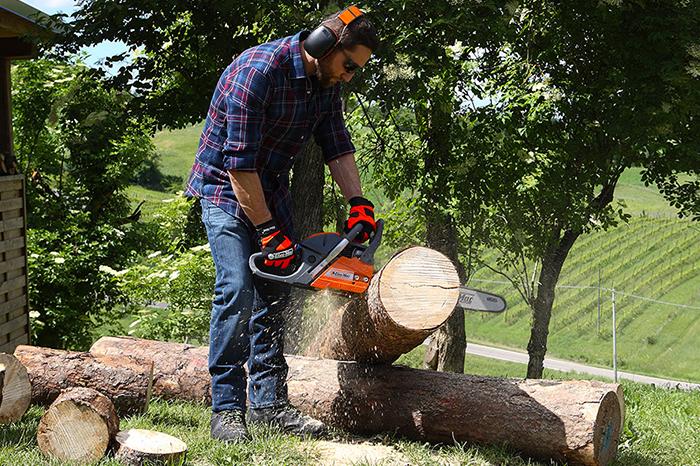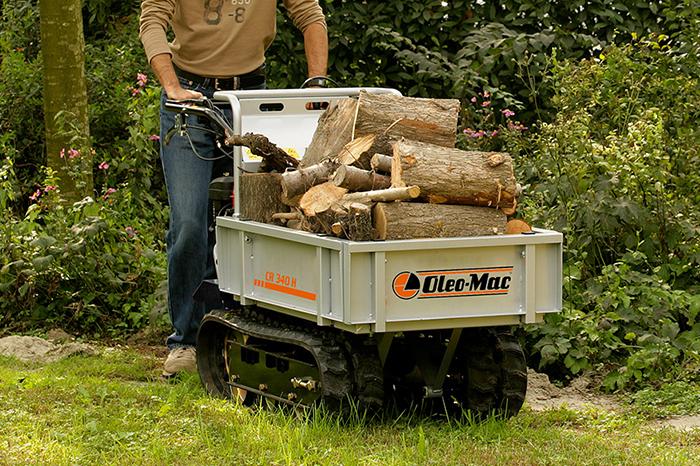Limbing, sectioning and bucking

Do you need to fell trees in gardens, parks or woods? Do you cultivate trees intensively to produce wood? In both cases, you need to know how to limb trees and saw felled timber into logs, also known as sectioning or bucking.
These procedures yield an assortment of timber of differing shape, quality, potential uses and value: from the portions of the trunk for making veneer sheets, to that used for household or construction carpentry, to firewood, which is obtained from the branches.
In the following paragraphs we discuss the chainsaw techniques to use for removing branches and bucking felled timber.
Limbing trees and bucking felled timber
After having felled a tree, carry out limbing to remove all the branches and the tree top, i.e. the highest part of the trunk, having a diameter less than 8-10 cm in conifers and 5-7 cm in broad-leaved trees. Limbing also involves removing the largest branches (limbs) from the lateral branches. After limbing the tree, proceed to saw up the trunk (also called bucking or sectioning) and branches into logs (bolts).
Use a chainsaw for limbing and bucking, and manual tools such as a billhook or axe to lop smaller branches. You will need a powerful professional chainsaw suitable for intensive use, such as the Oleo-Mac 956, which starts effortlessly thanks to the decompressor, and which can be fitted with a 46 cm or 51 cm guide bar.
To carry your chainsaw and other tools, as well as transport logs and branches, you can use a tracked wheelbarrow capable of traversing sloping and uneven terrain. With the Oleo-Mac CR 340 K compact transporter you can load up to 350 kg on the 45° tilting platform—which is expandable up to 106x90 cm and has adjustable sides—and travels at up to 3.6 km/h. Incidentally, in this blog article you will find more information on why to choose a transporter.
Limbing and bucking are demanding activities that should be performed calmly, using proper technique and adopting the necessary safety precautions. The chainsaw and other tools you will use for this task are very sharp and dangerous, especially in the event of kickback or an unexpected sudden release of tension from a tree during cutting. In addition, this procedure requires you to maintain the same posture for hours, placing strain on your back, legs and knees. For all these reasons, it is essential to wear approved protective clothing that safeguards you from cuts and provides the necessary comfort to make your job easier.




How to limb with a chainsaw
For conifers there are different chainsaw limbing techniques: pendulum, Scandinavian and top-first. With each of these techniques, always start from the butt (base) of the tree and work up towards the top.
In particular, the pendulum technique allows you to limb smaller branches (less than 1.5 cm in diameter) quickly by undercutting them using the top of the guide bar, i.e. with a pushing chain. To perform this task successfully, proceed as follows:
- Position yourself squarely facing the trunk, with the tree top on your left and the butt on your right.
- Saw the branches on the left side of the trunk using a forward sweep towards the tree top.
- Change direction and saw the branches on top of the trunk by sweeping backwards towards the butt of the trunk.
- Finally, pass the chainsaw over to the right side of the trunk and make another forward sweep towards the tree top.
- Follow the same procedure to saw the next rounds (whorls) of branches.
With this method you sweep the chainsaw first towards your left, then to the right and finally to the left again, limbing around 1 m of the trunk with each pass.
The Scandinavian method is instead used to limb branches up to 5 cm thick. This technique is also called the lever method, because you rest the weight of the chainsaw on the trunk and your right leg, using the saw as a lever so that you expend as little effort as possible.
Alternate between cutting with a pushing chain and cutting with the underside of the guide bar (pulling chain), as follows:
- Keeping the trunk on your right-hand side, stand with your feet planted at a 45-degree angle to the trunk.
- Keep your right leg supported against the trunk.
- Start limbing the first round of branches, beginning with those on the right side of the trunk, before proceeding to saw those on top of the trunk and finally those on the left side.
- Cut the next round of branches, this time starting from the left side of the trunk (where you just finished sawing, so that minimal repositioning of the saw is required), proceeding towards the rear and then towards the right of the trunk.
- Repeat the procedure for the upper whorls of branches, passing the chainsaw from the right side of the trunk to the left and vice versa.
For thicker branches (diameter over 5 cm) and tensioned branches, use the top-first method and start each step from the tensioned points. Instead of pruning long and tensioned branches in one pass, you can shorten them gradually, starting from the outer tip of the foliage and working towards the bole.
As with the other techniques, when using the top-first technique remember to alternate between cutting with a pulling and pushing chain. Here are the instructions:
- Keep the trunk on your right-hand side, standing with your feet planted at a 45-degree angle to the trunk.
- For each whorl of branches, start by sawing the branch on top of the trunk.
- Slide the saw down to the branches on the left side of the trunk and then saw those on the right side.
- Repeat the passes with the chainsaw for the upper whorls of branches.
When limbing broad-leaved trees with a chainsaw, you still start from the base of the tree and work upwards, but using a different method to the one used for conifers.
Firstly, remove any stumps, protuberances etc. from the section of trunk below the crown using the same limbing methods as for conifers. Now face towards the crown:
- Start working on the left side of the bole.
- Work around the crown, sawing the outermost end of the branches.
- Repeat the process, sawing up to another 2 m off each branch, gradually shortening them until the tree is completely delimbed.


Bucking felled timber: how to do it
Once you have finished limbing a tree trunk using a chainsaw, it’s time to proceed with bucking. If you have felled the tree to sell wood, this is an essential step that enables you to minimise waste and therefore maximise your profit. The cutting techniques for bucking depend on the trunk diameter and the internal tensions of the wood as a result of felling, so before starting, check whether the tree is supported on the ground or suspended on stones, other trunks etc.
To buck untensioned trunks (or trunks with minimal tension):
- Small diameter: a simple cut is sufficient, starting from the tensioned zone, with the chainsaw horizontal if there is space under the trunk, or with the chainsaw angled if the trunk is on the ground (make sure that the chainsaw's guide bar does not contact the ground, to avoid kickback).
- Medium diameter: use the fan cut technique, by alternately lowering the guide bar and rear handle of the chainsaw.
- Large diameter, up to 1.3 times greater than the guide bar length: before sectioning the trunk, make two cuts to reduce its diameter, the first one with the chainsaw horizontal and the second one, on the opposite side from where you are standing, with the chainsaw vertical.
- For even thicker trunks, make fan cuts, working first on one side of the bole and then on the other.
To section trunks under limited tension:
- Start from the compressed area, cutting about 1/3 through the diameter or until the chain slows down due to being pinched by the wood.
- Pull out the guide bar and start sawing on the opposite side to complete the cut. In the case of trunks of greater diameter than the length of the guide bar, make an initial horizontal cut in the compressed area, then one or two vertical cuts to reduce the diameter.
- Proceed with bucking by sawing the tensioned area, making sure to leave a hinge—an uncut portion of trunk about 1/10 of the total diameter—so that the bolt does not detach suddenly, leaving you enough time to move away.
For trunks under high tension:
- Make a preliminary cut in the compressed area, then cut into the tensioned area, leaving the hinge and the outermost part of the trunk uncut.
- Cut away the ends of the hinge and saw through the remaining tensioned part of the trunk, being careful when the bolt detaches.
- Proceed in a similar way for thicker trunks, but first gradually reduce the section to be cut, as mentioned in the previous paragraph.
When bucking timber, if the guide bar becomes trapped in a cut, do not pull the chainsaw out. Instead switch it off and, using a strong branch, prize open the cut until you can remove the guide bar. Never start the chainsaw when the guide bar is trapped in a cut.



